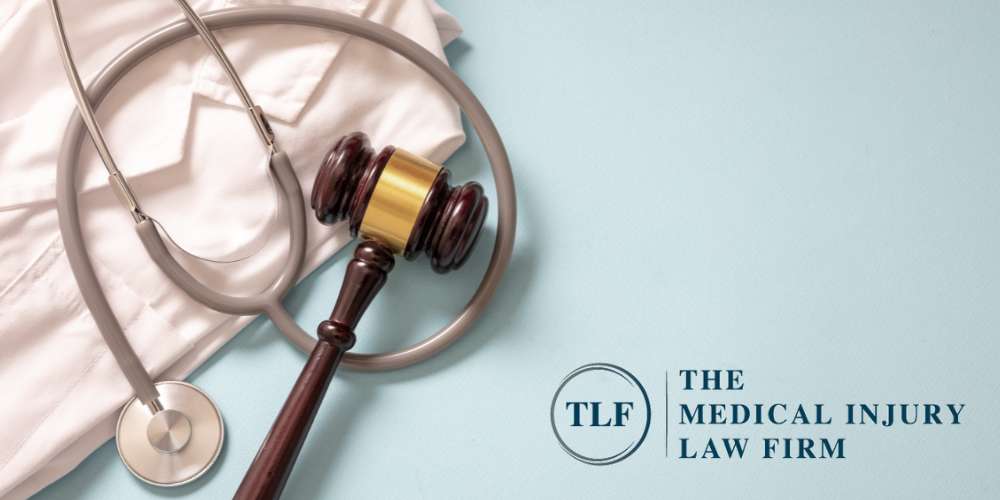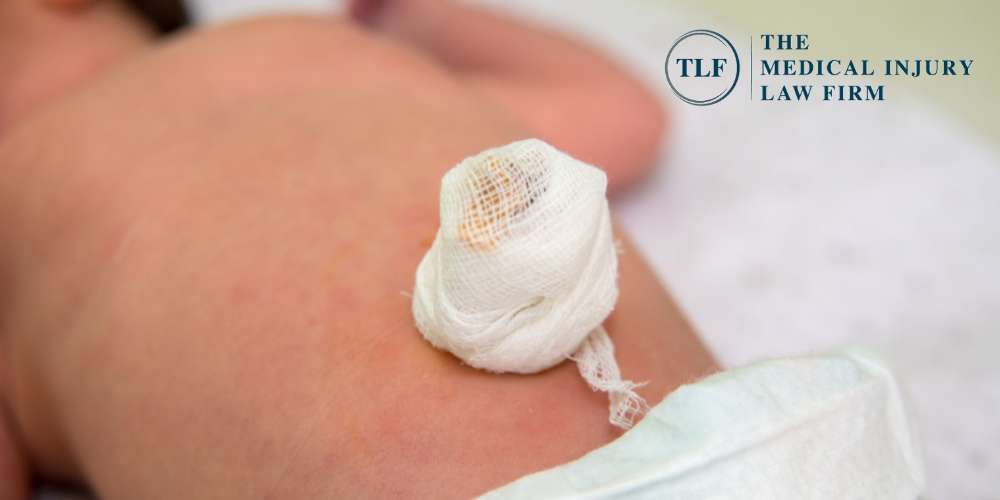As an expectant parent, there are a lot of questions you might have about the childbirth process and the potential complications that may arise. One rare but serious issue that can occur is umbilical cord prolapse. But what is cord prolapse? How does it happen? Can umbilical cord prolapse lead to birth injuries?
Cord prolapse is a rare but potentially life-threatening complication that can occur during childbirth. It happens when the umbilical cord slips out through the cervix and into the birth canal ahead of or alongside the baby, rather than remaining safely behind the baby prior to delivery.
If you or a loved one have experienced a birth injury due to cord prolapse, don’t hesitate to seek legal guidance from an experienced medical malpractice attorney at TLF: The Medical Injury Law Firm. Our Northern Kentucky and Ohio birth injury attorneys stand ready to help you seek compensation for your losses during this difficult time.
Call us toll-free at (800) 698-4054 or reach out online to schedule a free consultation with an attorney on our team today.

What is Umbilical Cord Prolapse?
Umbilical cord prolapse is a childbirth complication where the umbilical cord slips into the birth canal ahead of the baby. When the umbilical cord prolapses, it can become compressed by the baby’s body during delivery. This can reduce or cut off the flow of oxygen to the baby, which can lead to serious health risks if not promptly addressed.
There are a few different ways that an umbilical cord prolapse can present itself, depending on the location of the umbilical cord in relation to the baby. This includes occult prolapse, overt prolapse, and funic presentation. We’ll cover these in more detail below.
Occult Umbilical Cord Prolapse
Occult umbilical cord prolapse, also known as a nonovert prolapse, occurs when the umbilical cord is delivered alongside the baby’s head rather than before, which can cause cord compression. When the umbilical cord does not pass through the cervix ahead of the baby, it can make it difficult for medical professionals to know that the cord has prolapsed.
Overt Umbilical Cord Prolapse
Overt umbilical cord prolapse is a childbirth complication where the umbilical cord slips into the birth canal ahead of the baby and becomes visible outside the mother’s womb. An overt prolapse can also cause the cord to become compressed during childbirth. However, since it can be more easily detected than other types of prolapse, labor and delivery can order an emergency c-section once detected to prevent compression.
Funic Presentation
Funic presentation with umbilical cord prolapse occurs when the umbilical cord is positioned between the baby and the cervical opening before or during labor, leading to the cord’s descent into the birth canal ahead of the baby. This kind of cord presentation can also result in compression, increasing the risk of certain adverse outcomes.
Prolapsed vs. Compressed Umbilical Cord
There are a lot of similarities between a prolapsed umbilical cord and a compressed umbilical cord, but there are also a few key differences. A prolapsed cord occurs when the baby’s umbilical cord passes through the birth canal either ahead of the baby or alongside the baby during delivery.
On the other hand, cord compression occurs when pressure is applied to the umbilical cord, preventing the umbilical vessels from carrying oxygen-rich blood to the baby. Cord prolapse often leads to cord compression because, after prolapse, the baby’s body can put pressure on the cord, which can lead to serious health complications like birth asphyxia.

What Causes Cord Prolapse?
Most cord prolapse cases are the result of ruptured membranes prior to birth, abnormal fetal presentation, excessive amniotic fluid, multiple pregnancies, or long umbilical cord length. However, these factors do not necessarily mean that the umbilical cord will prolapse, they simply increase the risk of a cord prolapse.
Common Risk Factors for Prolapsed Umbilical Cord
There are a number of different risk factors that can increase the likelihood of a cord prolapse, so it’s important that mothers with one or more of these risk factors are closely monitored for potential cord prolapse:
- Premature Birth: Since pre-term babies are often smaller than full-term babies, they’re associated with an increased risk of umbilical cord prolapse. This is because the umbilical cord can more easily fall past the baby and present ahead of or beside the baby during delivery.
- Low Birth Weight: Similarly, low birth weight can also lead to a prolapsed umbilical cord due to the small size of the baby. Smaller babies leave more room in the uterus for the umbilical cord to move around, potentially allowing it to slip into the birth canal ahead of or alongside the baby.
- Long Umbilical Cord: A long umbilical cord provides the cord with more slack, allowing it to descend into the birth canal. During labor, especially when the baby’s head is not well-engaged in the pelvis, the extra length of the cord increases the risk of it slipping out of the uterus prematurely.
- Cephalopelvic Disproportion: Cephalopelvic disproportion (CPD) occurs when the baby’s head is disproportionately sized compared to the mother’s pelvis, making delivery difficult. This mismatch can prevent the baby from properly descending into the birth canal, leaving space for the umbilical cord to slip down.
- Excessive Amniotic Fluid (Polyhydramnios): Too much amniotic fluid, or polyhydramnios, can lead to a prolapsed umbilical cord. This is because the increased fluid volume creates extra space in the uterus, allowing the cord to move more freely. During labor, when the membranes rupture, the sudden gush of fluid can wash the umbilical cord into the birth canal.
- Multiple Pregnancies: Multiple pregnancies, such as twins or triplets, can lead to a prolapsed umbilical cord, as the presence of more than one baby creates additional space in the uterus for the umbilical cord to become misplaced, such as velamentous and marginal cord insertion.
- Abnormal Fetal Presentation: One of the main risk factors for umbilical cord prolapse is abnormal fetal presentation, like breech presentation, which occurs when the baby’s head is not engaged in the pelvis during labor. Abnormal presentation can create extra room inside the uterus, allowing the umbilical cord to fall past or beside the fetal presenting part.
- Ruptured Membranes: Another common risk factor for umbilical cord prolapse is membrane rupture. When the mother’s amniotic sac ruptures, there’s a higher chance for the cord to descend before the baby, increasing the risk of prolapse.

Signs of Cord Prolapse During Labor
The most obvious sign of cord prolapse during labor is the presence of a mass within the birth canal before delivery, but cord prolapse isn’t always easy to detect. Other signs include prolonged fetal bradycardia, or severe variable decelerations in fetal heart rate. Any of these signs warrant immediate medical attention to address the prolapse and ensure the safety of both the baby and the mother.
What is the Biggest Risk of a Prolapsed Cord?
The biggest risk of a prolapsed cord is the potential for umbilical cord compression, which can lead to a significant decrease or complete cut off of blood flow and oxygen to the baby. This can result in serious complications such as fetal distress, birth asphyxia, hypoxia, and even stillbirth if not promptly addressed through emergency medical intervention (typically via a cesarean section).
Umbilical Cord Prolapse Nursing Interventions
There are a number of things that nurses can do if they suspect umbilical cord prolapse by alleviating pressure on the umbilical cord and preventing serious injury to the child. One common intervention is to move the mother into a knee-to-chest position or Trendelenburg position to encourage the baby to move off the cord.
Nurses and doctors should also continually monitor the mother’s vital signs as well as the baby’s heart rate to promptly detect any signs of distress. Negligent maternal or fetal monitoring could constitute hospital, nursing or nurse-midwife negligence.
The Importance of Timely Intervention
Timely intervention is crucial when it comes to cord prolapse because it can prevent serious complications for the baby and mother. Immediate medical attention is necessary to relieve pressure on the cord and restore blood flow and oxygen to the baby. Failing to intervene in time, such as failing to perform a C-section, could result in serious birth injuries or even fetal death.

Medical Malpractice and Cord Prolapse
Medical malpractice occurs when medical professionals provide patients with substandard care, resulting in serious injuries or other losses. In labor and delivery, doctors and nurses are responsible for mitigating any potential issues before, during, and after delivery. When they fail to do so, they may be sued for labor and delivery malpractice.
In cord prolapse cases, medical professionals are negligent if they fail to recognize the signs and symptoms of prolapse or fail to properly implement appropriate interventions. Overall, any deviation from the standard of care that results in harm to the mother or baby may be considered medical malpractice in cord prolapse cases.
How TLF: The Medical Injury Law Firm Can Help
In general, it is difficult to prove that a birth injury was the result of medical negligence, especially without the help of an experienced birth injury attorney like the attorneys at TLF. If your child has suffered from injuries as a result of cord prolapse and you suspect it’s the result of medical negligence, contact a Kentucky or Cincinnati medical malpractice lawyer at TLF: The Medical Injury Law Firm right away.
With a deep understanding of medical malpractice laws, the medicine, and extensive experience in birth injury cases, our legal team can thoroughly investigate the circumstances surrounding the cord prolapse. We’ll identify instances of medical negligence and advocate fiercely for your rights both inside and outside of court.
At TLF, our attorneys work closely with medical experts, who can provide expert testimony in medical malpractice cases. Additionally, we’ll work hard to quantify the full extent of your damages, including medical expenses, future care needs, pain and suffering, and lost earning capacity, holding negligent medical professionals responsible for their actions.

Potential Birth Injury Claim? Learn More By Scheduling a Free Consultation With the Medical Malpractice Attorneys at TLF Today
Umbilical cord prolapse can result in serious negative outcomes for newborn infants, and when medical professionals fail to manage it correctly, they should be held liable for their actions. At TLF: The Medical Injury Law Firm, our experienced malpractice attorneys know what it takes to make sure they are.
Our skilled attorneys will evaluate your claim, gather evidence to prove liability, and build a strong case on your behalf, ensuring you have the best chance of receiving justice. Our goal is to help you understand your legal options and pursue the compensation you deserve for your child’s injuries, medical expenses, and other related damages.
TLF proudly provides dedicated legal representation to medical malpractice victims in Ohio and Kentucky. We also provide each client with a free initial consultation regarding their case and offer contingency fee arrangements ensuring they can receive knowledgeable legal guidance regardless of their ability to pay.
To get in touch, simply call our Cincinnati, OH, office at (513) 651-4130, or our Covington, KY, office at (859) 578-9130, or toll-free at (800) 698-4054. You can also contact us through our online intake form today.

